| 1970s in video games . 1980s |
| Other topics: Anthropology . Comics . Fashion . Music . Science and technology . Sociology . Television |

The 1970s was the first decade in the history of the video game industry. The 1970s saw the development of some of the earliest video games, chiefly in the arcade game industry, but also several for the earliest video game consoles and personal computers.
Notable games released in the 1970s included Computer Space, The Oregon Trail, Pong, Space Invaders, Asteroids, Galaxian, Combat, Breakout, Lunar Lander, Sea Wolf, and Zork.
Arcade history
Notable early arcade video games of the early-to-mid-1970s include Computer Space (1971), Pong (1972), Space Race (1973), Gotcha (1973), Speed Race (1974), Gun Fight (1975), Heavyweight Champ (1976), Fonz (1976), Night Driver (1976), Breakout (1976), Death Race (1976), Sea Wolf (1976), and Space Wars (1977).
Golden age of arcade video games (1978–1979)
Classic arcade games of the late 1970s include Space Invaders (1978), Galaxian (1979), Asteroids (1979), Barrier (1979), Speed Freak (1979), Warrior (1979), Tail Gunner (1979), and Lunar Lander (1979).
Consoles of the 1970s
First-generation consoles (1972–1979)
The first generation of consoles were on sale between 1972 and 1980 and included the Magnavox Odyssey, Telstar, Home Pong, and Color TV-Game.
Typical characteristics of the first generation of consoles:
- Discrete transistor-based digital game logic.
- Games were native components of consoles rather than based on external or removable media.
- Entire game playfield occupies only one screen.
- Players and objects consist of very basic lines, dots or blocks.
- Colour graphics are basic (mostly black and white or other dichromatic combination; later games may display three or more colors).
- Either single-channel or no audio.
- Games had a high score based system.
- Lacked features of second generation consoles, such as microprocessor logic, ROM cartridges, flip-screen playfields, sprite-based graphics, and multi-color graphics.
Second-generation consoles (1976–1983)
The second generation of consoles, on sale between 1976 and 1988, made several leaps forward technologically. Consoles first available in the late 1970s included the Fairchild Channel F, Atari 2600, Bally Astrocade, and Magnavox Odyssey². The first handheld console, the Microvision, was released in 1979.
Typical characteristics of the second generation of consoles:
- Microprocessor-based game logic.
- AI simulation of computer-based opponents, allowing for single-player gaming.
- ROM cartridges for storing games, allowing any number of different games to be played on one console.
- Game playfields able to span multiple flip-screen areas.
- Blocky and simplistic-looking sprites, with a screen resolution of around 160 × 192 pixels.
- Basic color graphics, generally between 2-color (1-bit) and 16-color (4-bit).
- Up to three channel audio.
- Lacked features of third-generation consoles, such as scrolling tile-based playfields.
Notable video game franchises established in the 1970s
Arcade
- Asteroids (1979)
- Breakout (1976)
- Galaxian (1979)
- Head On (1979)
- Pong (1972)
- Space Invaders (1978)
- Speed Race (1974)
- Sprint (1976)
- Tank (1974)
Home computers and console
- Battlestar Galactica1 (1976)
- Empire (1977)
- dnd (1975)
- Flight Simulator (1979)
- The Oregon Trail (1971)
- Sargon (1978)
- Superman1 (1979)
- Star Trek1 (1979)
- Star Wars1 (1979)
- Zork (1977)
Notes:
- 1 Game franchises that also accompany major film or television franchises.
Financial performance
Best-selling arcade games of the decade
The following titles were the best-selling arcade games of each year in the 1970s.
| Year | Region(s) | Type | Title | Cabinet sales | Revenue | Inflation | Developer | Manufacturer(s) | Genre | Ref |
|---|---|---|---|---|---|---|---|---|---|---|
| 1979 | Worldwide | — | Space Invaders | 750,000 | $1,000,000,000+ | $4,500,000,000+ | Taito | Taito / Midway | Shoot 'em up | [1][2] |
| 1978 | ||||||||||
| 1977 | Japan | Electro-mechanical | F-1 | Unknown | Unknown | Unknown | Namco | Namco | Racing | [3][4] |
| Medal game | EVR Race | Unknown | Unknown | Unknown | Nintendo | Nintendo | ||||
| Video game | Speed Race DX | Unknown | Unknown | Unknown | Taito | Taito | ||||
| USA | — | Sea Wolf | 10,000 | Unknown | Unknown | Dave Nutting Associates | Midway | Shooter | [5][6][7] | |
| 1976 | USA | — | ||||||||
| Japan | Electro-mechanical | F-1 | Unknown | Unknown | Unknown | Namco | Namco | Racing | [8][4] | |
| Medal game | EVR Race | Unknown | Unknown | Unknown | Nintendo | Nintendo | ||||
| Video game | Ball Park (Tornado Baseball) | Unknown | Unknown | Unknown | Midway Manufacturing | Taito | Sports | |||
| 1975 | USA | Video game | Wheels / Wheels II (Speed Race) | 10,000 | Unknown | Unknown | Taito | Midway | Racing | [9] |
| 1974 | USA | Video game | Tank | 10,000 | Unknown | Unknown | Kee Games | Kee Games / Atari | Maze | |
| 1973 | USA | Video game | Pong | 8,000 | $11,000,000 | $73,000,000 | Atari, Inc. | Atari, Inc. | Sports | [9][10] |
| 1972 | USA | Video game | Computer Space | 200 | Unknown | Unknown | Syzygy Engineering | Nutting Associates | Space combat | [9] |
Best-selling home systems of the decade
| Rank | System | Release | Manufacturer | Type | Generation | Sales | As of | Ref |
|---|---|---|---|---|---|---|---|---|
| 1 | Nintendo Color TV Game | 1977 | Nintendo | Console | First | 2,000,000 | 1979 | [11] |
| 2 | Atari Video Computer System (Atari VCS) | 1977 | Atari, Inc. | Console | Second | 1,550,000 | 1979 | [12] |
| 3 | Coleco Telstar | 1976 | Coleco | Console | First | 1,000,000 | 1976 | [13] |
| 4 | TRS-80 | 1977 | Texas Instruments | Computer | 8-bit | 450,000 | 1979 | [14] |
| 5 | Magnavox Odyssey | 1972 | Magnavox | Console | First | 367,000 | 1975 | [15] |
| 6 | Fairchild Channel F | 1976 | Fairchild Camera and Instrument | Console | Second | 350,000 | 1979 | [16] |
| 7 | Epoch TV Baseball | 1978 | Epoch Co. | Console | First | 230,000 | 1979 | [17] |
| 8 | Epoch TV Game System 10 | 1977 | Epoch Co. | Console | First | 200,000 | 1979 | [17] |
| 9 | Home Pong | 1975 | Atari, Inc. | Console | First | 150,000 | 1975 | [18] |
| NEC PC-8001 | 1979 | NEC | Computer | 8-bit | 150,000 | 1979 | [19] |
Hardware timeline
The following gallery highlights hardware used to predominantly play games throughout the 1970s.
 Pong arcade machine (1972)
Pong arcade machine (1972)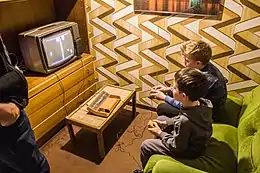 Home Pong console (museum recreation)
Home Pong console (museum recreation)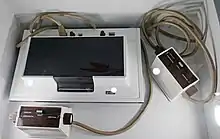 Magnavox Odyssey (1972)
Magnavox Odyssey (1972)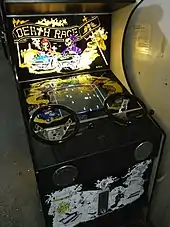 Death Race (1976)
Death Race (1976) Fairchild Channel F (1976)
Fairchild Channel F (1976) Apple II (1977)
Apple II (1977) TRS-80 (1977)
TRS-80 (1977)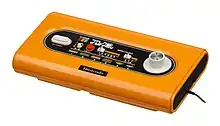 Color TV-Game (1977)
Color TV-Game (1977).jpg.webp) Commodore PET (1977)
Commodore PET (1977) Atari CX40 joystick (1978)
Atari CX40 joystick (1978)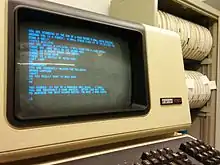 VT100 (1978)
VT100 (1978) Intellivision (1979)
Intellivision (1979) Asteroids (1979)
Asteroids (1979) Microvision (1979)
Microvision (1979)_Galaxian_and_very_early_Midway_(USA)_Galaxian_arcade_machines.jpg.webp) Galaxian (1979)
Galaxian (1979)
References
- ↑ "After Pong". ACE. No. 6 (March 1988). 4 February 1988. pp. 29-32 (29).
- ↑ Sullivan, George (1983). "The First Big Hits". Screen Play: The Story of Video Games. F. Warne. p. 38-47 (40). ISBN 978-0-7232-6251-0.
- ↑ "結果ベスト3" [Best 3 Results] (PDF). Game Machine (in Japanese). No. 90. Amusement Press, Inc. 15 February 1978. pp. 2–3.
- 1 2 "調査対象5年間のベスト1" [Best 1 of the 5 Years Surveyed] (PDF). Game Machine (in Japanese). No. 159. Amusement Press, Inc. 15 February 1981. p. 1.
- ↑ "Top Arcade Games". Play Meter. November 1977.
- ↑ "Profit Chart". RePlay. October 1976.
- ↑ Steven L. Kent (2000), The first quarter: a 25-year history of video games, BWD Press, p. 83, ISBN 0-9704755-0-0, retrieved 2011-04-09,
Sea Wolf, which was another creation of Dave Nutting, did solid business, selling more than 10,000 machines.)
- ↑ "本紙アンケー 〜 ト調査の結果" [Paper Questionnaire: Results of the Survey] (PDF). Game Machine (in Japanese). No. 65. Amusement Press, Inc. 1 February 1977. pp. 2–3.
- 1 2 3 Baer, Ralph H. (2005). Videogames: In the Beginning. Rolenta Press. pp. 10–3. ISBN 978-0-9643848-1-1.
- ↑ Barack, Lauren (8 May 2003). "In Blast From the Past, Atari Video Games Plan a Return". New York Post. p. 34. Archived from the original on 2012-05-12.
Its first hit game, "Pong," launched in 1972, made $11 million in revenue in just one year.
- ↑ Horowitz, Ken (2020-07-30). "Video Killed the Electromechanical Star". Beyond Donkey Kong: A History of Nintendo Arcade Games. McFarland & Company. p. 27. ISBN 978-1-4766-4176-8.
- ↑ Rubin, Michael (2006). "Eighteen: A Hole in the Desert [1982–1983]" (PDF). Droidmaker: George Lucas and the Digital Revolution. Triad Publishing Company. pp. 291-314 (293-4). ISBN 978-0-937404-67-6.
- ↑ Herman, Leonard (1997). Phoenix: the fall & rise of videogames (2nd ed.). Union, NJ: Rolenta Press. p. 20. ISBN 0-9643848-2-5. Retrieved 16 February 2012.
Coleco released Telstar in 1976. Like Pong, Telstar could only play video tennis but it retailed at an inexpensive $50 that made it attractive to most families that were on a budget. Coleco managed to sell over a million units that year.
- ↑ Reimer, Jeremy (2005-12-15). "Total share: 30 years of personal computer market share figures". Ars Technica. Archived from the original on 2012-06-07. Retrieved 2021-11-27.
- Jeremy Reimer (2012-12-07). "Total Share: Personal Computer Market Share 1975-2010". Jeremy Reimer.
- ↑ Smith, Alexander (November 27, 2019). They Create Worlds: The Story of the People and Companies That Shaped the Video Game Industry. Vol. 1: 1971 – 1982. CRC Press. pp. 207–9. ISBN 978-1-138-38990-8.
- ↑ Edwards, Benj (January 22, 2015). "The Untold Story Of The Invention Of The Game Cartridge". Fast Company. Retrieved July 29, 2020.
- 1 2 "昔(1970年代)のテレビゲームは何台売れた?" [How many old (1970s) video games sold?]. Classic Videogame Station Odyssey (in Japanese). Archived from the original on 2014-01-09. Retrieved 16 April 2021.
- ↑ Ellis, David (2004). "Dedicated Consoles". Official Price Guide to Classic Video Games. Random House. pp. 33–36. ISBN 0-375-72038-3.
- ↑ West, Joel (January 1996). "Moderators of the Diffusion of Technological Innovation: Growth of the Japanese PC Industry" (PDF). Center for Research on Information Technology and Organizations. University of California, Irvine. pp. 9–10. alternate url
